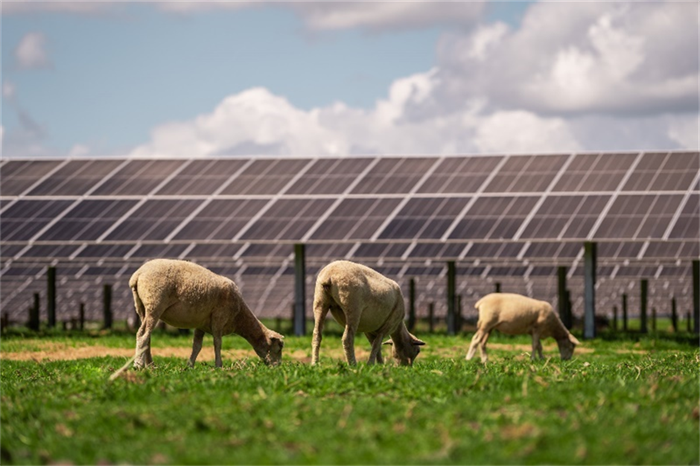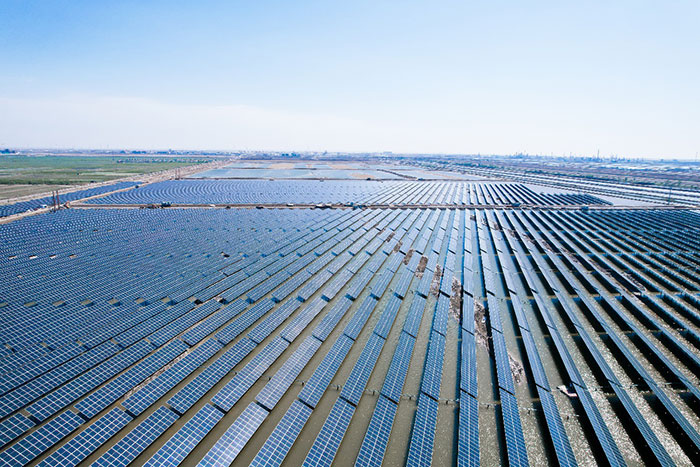
Credit: Lodestone Energy
Solar energy is rapidly developing worldwide. Beyond its well-known advantages—such as promoting environmental consciousness and harnessing advanced technologies—new benefits have emerged with the combination of solar and agricultural projects. This innovative approach is well-suited to the conditions in Uzbekistan.
What is Agrivoltaics?
Agrivoltaics is an innovative approach that combines solar energy generation with agricultural production on the same piece of land. By installing solar modules above farmland, agrivoltaics allows for both farming and clean electricity generation simultaneously, maximizing land use without sacrificing crop yields.
It offers multiple benefits: reduces the need for additional land for solar farms, supports local economies by creating jobs, and increases agricultural productivity. A variety of crops, such as pumpkins, corn, and mushrooms, thrive under solar modules, and livestock like sheep or yak can also graze beneath them. Additionally, the crops help to cool the ground, which can improve the efficiency of solar energy generation.
At the Forefront of Agrivoltaics
Trinasolar, a leader in smart photovoltaic and energy storage solutions, recently announced the commercial operation of its agrivoltaics project in Fukuchiyama, Kyoto, Japan. Developed by its International System Business Unit, this project marks a significant milestone, showcasing the synergy between renewable energy and agriculture.
The Fukuchiyama project features 3,392 of Trinasolar's Vertex N 720W series modules, designed with cutting-edge technology to deliver high efficiency. It aims to generate 2,700 MWh of clean energy annually, reducing carbon dioxide emissions by about 1,760 tons each year. Its agrivoltaics approach supports the cultivation of Japanese yam, a crop that thrives under the shade provided by the solar modules due to its low light saturation point. The shade from the modules also reduces soil moisture evaporation, helping retain water—essential for yam cultivation, typically done in moist conditions like paddy fields. This solution not only optimizes land use but also creates a microclimate that enhances crop growth.
Why it Matters for Uzbekistan
Agriculture is a cornerstone of Uzbekistan's economy, and like solar energy, it benefits greatly from the country's abundant sunlight. The country has ambitious plans for agricultural development. For example, the European Union recently agreed to allocate 20 million euros to support the implementation of the National Strategy for Agricultural Development for 2020-2030, aiming to strengthen this vital economic sector, which is also the primary source of employment.
Additionally, during a meeting with President Shavkat Mirziyoyev this summer, a three-year program was proposed to create industrial orchards and vineyards on 75,000 hectares of inefficient orchards and 100,000 hectares of low-yield land. These orchards will be eligible for preferential loans through the Agricultural Fund, providing essential support for this initiative.
However, Uzbekistan faces a growing challenge: water scarcity, as noted in the National Environmental Report. Experts attribute this issue to population growth, increased demand for food and energy, and the impacts of climate change. These challenges underscore the urgent need for sustainable solutions that can address both resource shortages and environmental concerns.

Fishery Photovoltaic Project in Cangzhou, China
Emerging Opportunities
Agrivoltaics offers a dual-use strategy for land, combining solar energy production with agriculture. Given the government's ambitious plans to expand solar energy, this approach presents a significant opportunity for the agricultural sector. Integrating solar power with agriculture could enhance land productivity, reduce water usage, and promote sustainable farming practices. This synergy aligns perfectly with Uzbekistan's goals of expanding both renewable energy and agricultural development, creating a pathway to optimize resources and boost the economy.
Trinasolar's innovative “PV+” model was central to the success of the Japanese project mentioned above. The modules are mounted at a minimum height of 2.35 meters, with rows spaced to accommodate agricultural machinery like tractors and rotary tillers. This thoughtful design ensures that farming operations can continue smoothly beneath the modules, promoting sustainable land use and contributing to the local economy.
However, Trinasolar's experience in Japan is not an isolated success story. The company has been at the forefront of agrivoltaics worldwide. For instance, Trinasolar recently collaborated with New Zealand's leading solar generation company, Lodestone Energy, to complete one of t New Zealand's largest solar farm to date — the Kohirā solar farm. This landmark project was not only Trinasolar's first integrated module and TrinaTracker project in the Oceanic region but also set a new standard for solar energy integration and innovation.
One of the most fascinating aspects of the Kohirā solar farm is its implementation of agrivoltaic farming, made possible by the use of Trina Tracker Vanguard 2P trackers. These trackers' design allows for ample space between the panel rows and a 2-meter height, providing the perfect conditions for the coexistence of solar energy generation and agricultural activities, such as grazing sheep or growing crops, beneath the solar panels.By maximizing land use efficiency, this dual-purpose system not only generates renewable energy but also supports local agricultural initiatives—an approach that holds great promise for regions like Uzbekistan, where sustainable land use is crucial.
Another example of how solar energy can integrate with traditional industries is through fishery-photovoltaic projects, like a 70MW installation in Hubei, China utilizing Trinasolar's Vertex 600W+ ultra-high-power modules. This project transformed saline mudlands into productive fish farms. Solar panels installed above fish ponds not only produce energy but also help regulate water temperatures, reducing fish mortality. These diverse applications—from aquaculture to agriculture—demonstrate that solar energy can unlock new opportunities for sustainable development across various sectors.
Drawing inspiration from these successful global projects, Uzbekistan has the potential to adopt similar strategies that maximize land use efficiency. By implementing such advanced technologies and design approaches, Uzbekistan can align its development with its sustainability goals, advancing green energy while enhancing the resilience of its agricultural sector against climate change. Agrivoltaics thus offers a comprehensive solution that fosters economic growth, energy independence, and environmental sustainability.
“Uzbekistan's unique mix of abundant sunlight and strong agricultural roots makes it an ideal place for agrivoltaic solutions. With Trinasolar's experience and industry-leading PV solutions, we’re confident that we can work with Uzbekistan's renewable energy industry to bring similar success to what we’ve seen in other countries, supporting the country's renewable energy goals,” says Elva Wang, Group Director of South, Southeast & Central Asia, Trinasolar Asia Pacific.
